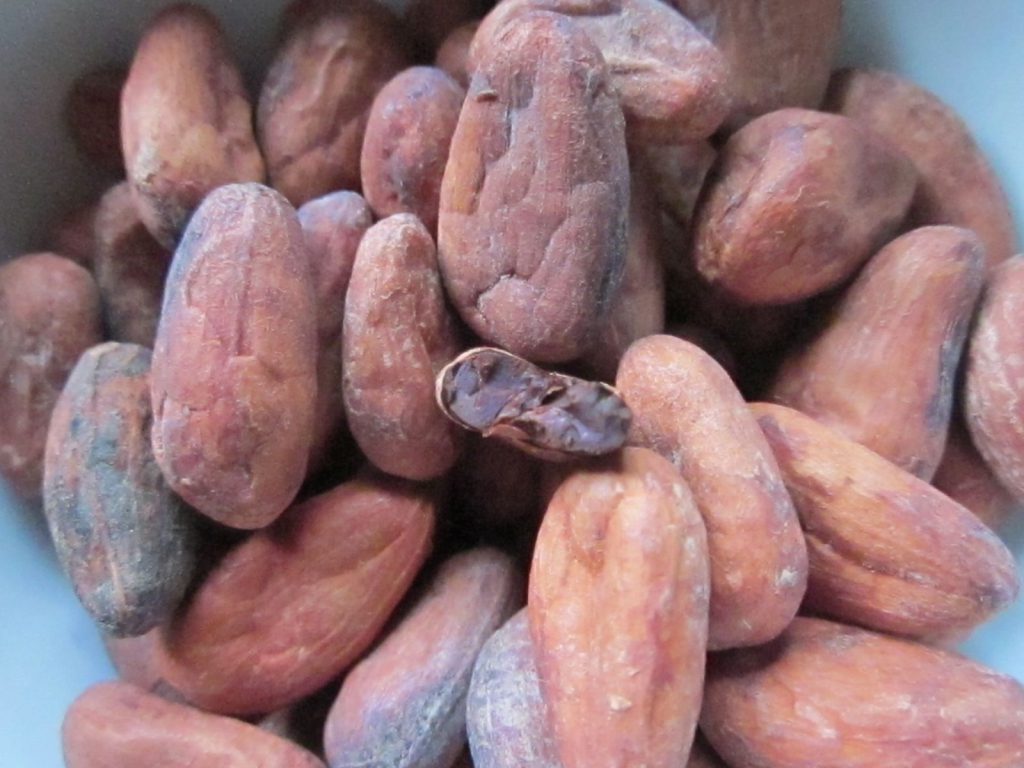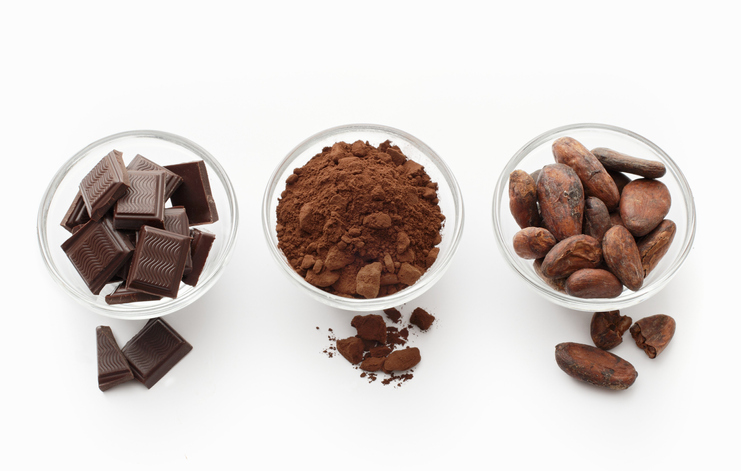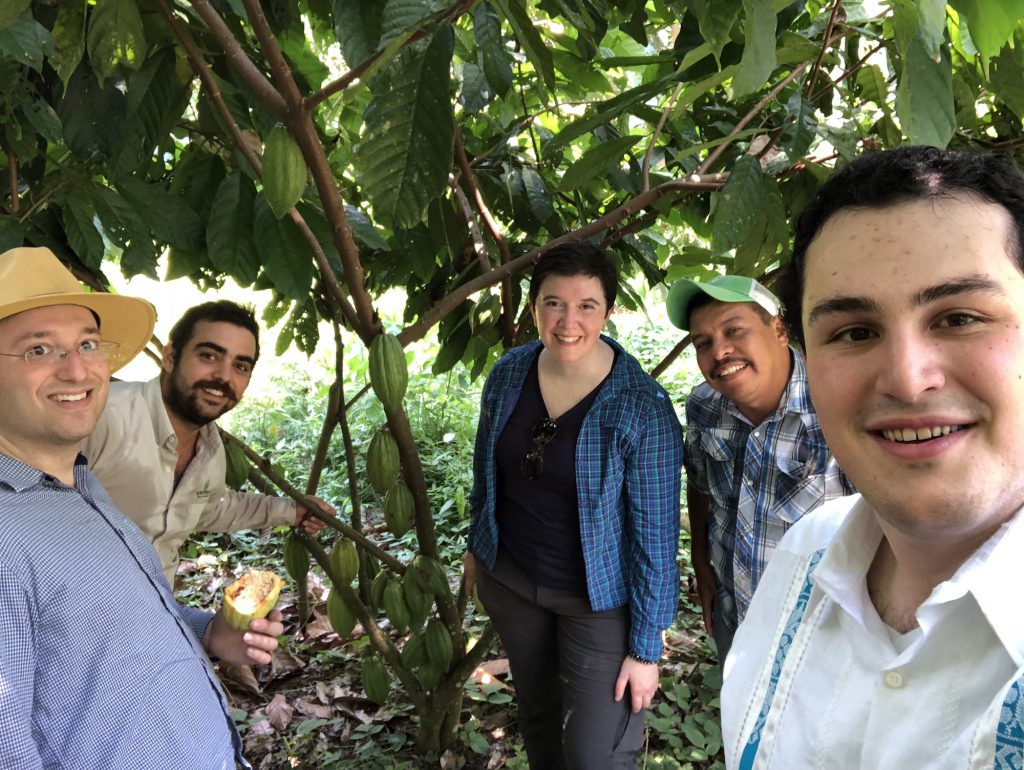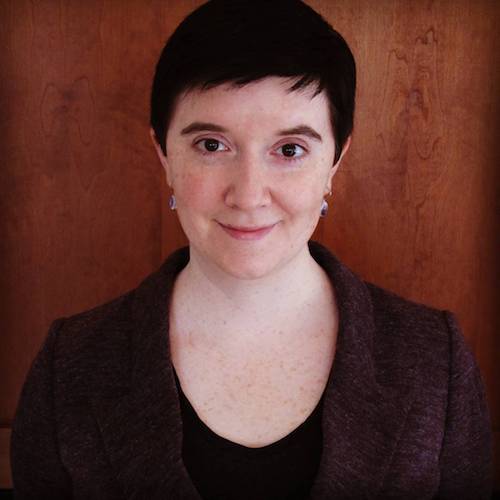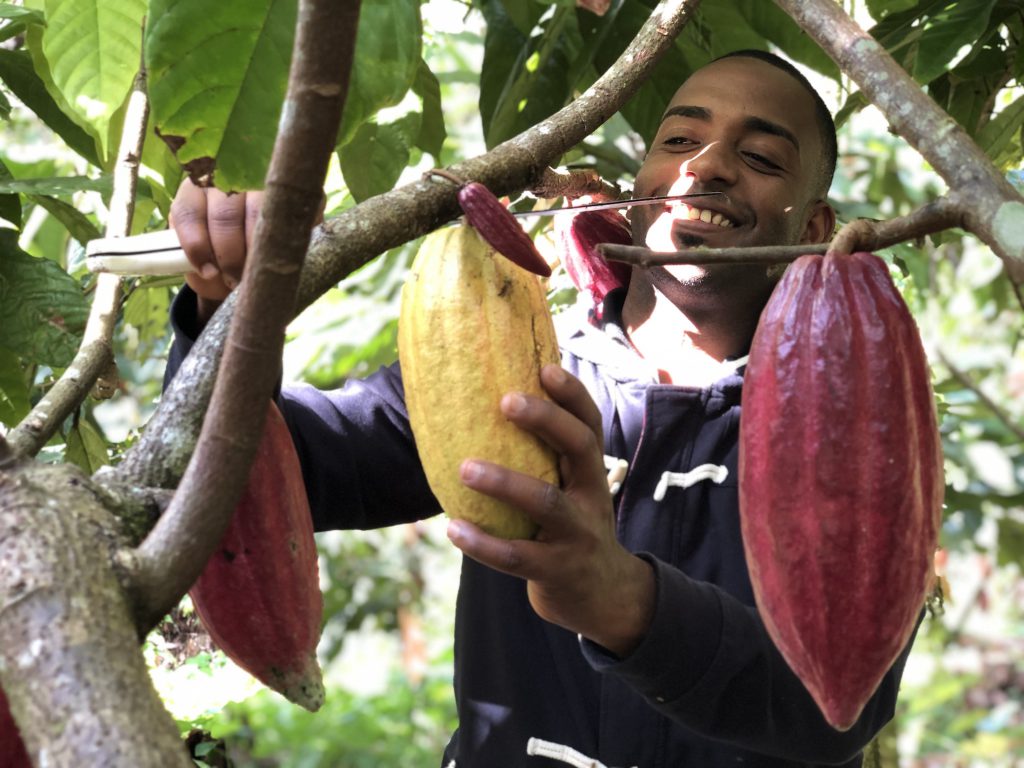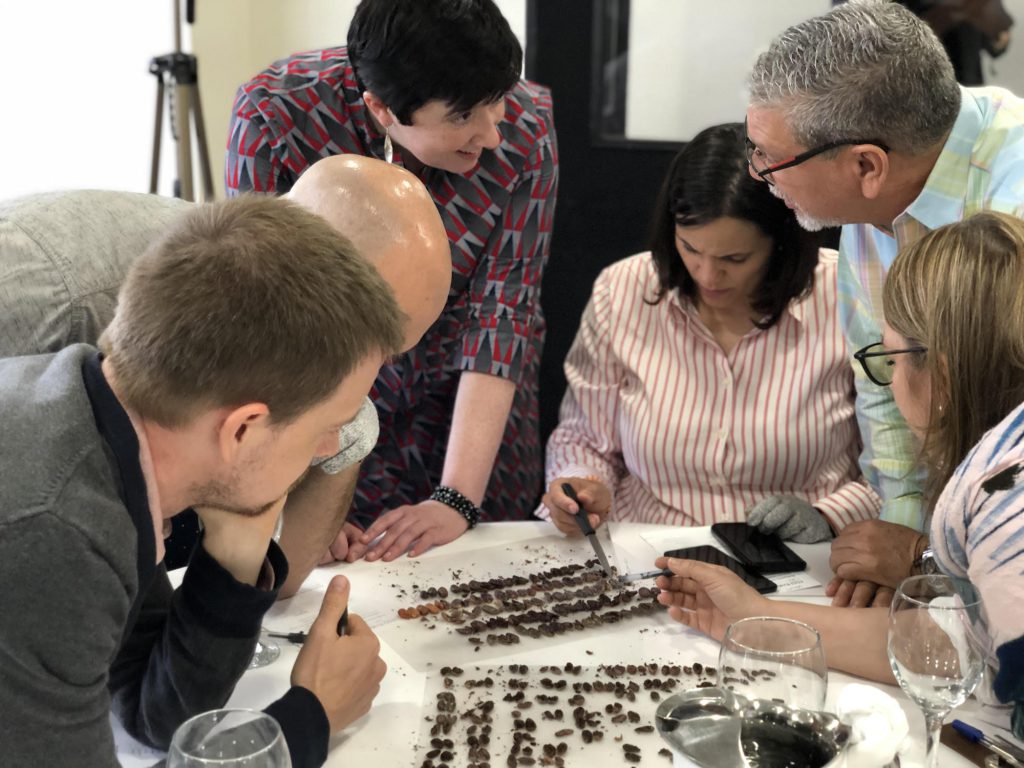The Bitter Side of Cocoa Production
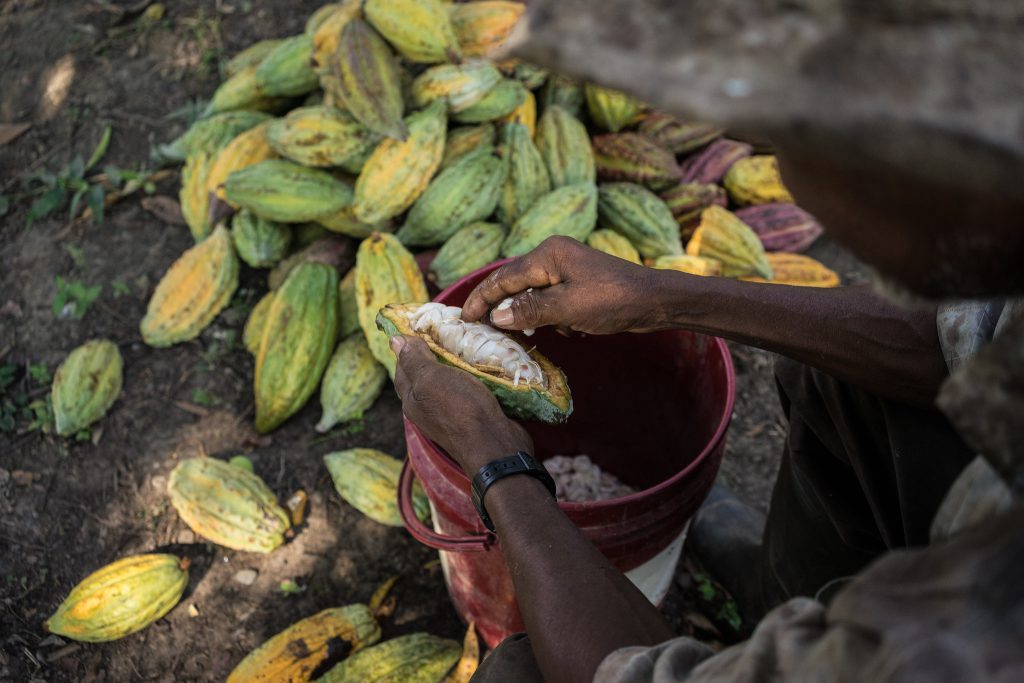
A fine piece of chocolate tickles your tongue with a complex mélange of flavors. The genetics of the cocoa beans, the plants’ terroir—that unique soil, climate, and terrain where the cocoa trees grow—and a myriad of variables involved in harvest and processing all leave a trace.
Heriberto Paredes, of Cotui, Dominican Republic, distinctly remembers the moment when he realized each of those flavors has a name. It was mid-March of 2019, and the 28-year-old agricultural engineering student was in a hotel conference room in Santo Domingo.
He was attending a workshop that involved, among other things, training the palate. With a first sip of flavored water, he experienced “una sensación extraña,” the strange sensation of tasting something vaguely familiar that he didn’t know quite how to describe.
Paredes learned to identify flavors such as acidity reminiscent of fresh lime or bitterness like burnt coffee. Over the course of three days, as the tasting protocol progressed through ground beans to finished chocolate, Paredes became adept at discerning subtle differences.
Paredes could perceive the percentage of cocoa in a sample chocolate, characterize additives such as sugar or salt, or pick up subtle notes of his favorite flavors: caramel and nuts. “Finally, I really understood what the chocolate makers were talking about,” he says.
The workshop was not limited to sensory training. The participants—including members from across the country’s cocoa sector—also spent several days at farms, chocolate factories, and the government-run research station learning about the cocoa supply chain and factors that affect the quality of the product.
The program is the brainchild of Carla Martin, an anthropologist at Harvard University and founder of the Fine Cacao and Chocolate Institute (FCCI), a nonprofit dedicated to researching and disseminating information on specialty, or high-end, cocoa. (Cacao is the word for the raw product and cocoa the name for the processed powder, though many people in the industry—and in this article—use the terms interchangeably.)
Cocoa production is beset by complex economic, social, and environmental problems, including poverty, child labor, and deforestation. Governments, nonprofits, manufacturers, and others have endeavored to tackle these issues—and none has wholly succeeded. “We’ve seen massive failures of the industry in terms of addressing these problems,” Martin says.
Though Martin does not believe she can solve all of cocoa’s evils either, she argues that what’s largely been missing from the discussion is strong social science: “We are facing these very real human problems and yet are missing the human element in our solutions.”
Martin’s hope with the workshops is to adapt her work as an applied anthropologist—one who uses the study of human cultures to help guide interventions—to listen to and amplify the voices of the cocoa producers. Only by capturing the actual experiences of people at every part along the supply chain, she and other social scientists argue, can the challenges of cocoa production truly be addressed.
Today Americans, Canadians, and Europeans consume the lion’s share of the more than US$100 billion worth of chocolate sold globally, but they do not grow cocoa. Meanwhile, Africa, the world’s largest cocoa producer, consumes only 3 percent, according to a 2010 report from the International Confectionary Association. Most cocoa grown in Africa is destined for export and processing elsewhere, so it’s never been integrated into local diets, Martin says.
Theobroma cacao is a small evergreen tree that thrives only in a narrow, 20-degree band on either side of the equator. The trees sprout autumn-colored, football-like fruit that contain a gelatinous white pulp encasing almond-sized seeds we know as cocoa beans. After harvesting, those beans are specially processed—fermented, roasted, ground, and blended with various ingredients—to become chocolate.
As much as 90 percent of the world’s cocoa is grown on small family farms of a few acres or less. Most of the 5 million or so growers live in poverty. The U.S. Department of Labor’s Bureau of International Labor Affairs estimates that 2 million children in the West African countries of Côte d’Ivoire and Ghana engage in hazardous work on the cocoa farms.
In addition, the cocoa industry has been blamed for destroying tropical rainforests. In their native habitat, cocoa trees grow under the protective forest canopy. Farmers can coax fast growth and higher yields through intensive use of herbicides and pesticides on cleared land.
A “slash-and-burn” approach to farming in West Africa has helped increase production fourfold since the 1960s, but the practice has decimated more than 90 percent of the original forests. Less than 4 percent of the once lush Côte d’Ivoire remains densely forested and several species—including chimpanzees, elephants, and the pygmy hippopotamus—are vulnerable or endangered.
In response to these varied troubles, researchers and advocates have examined several possible solutions. Kristy Leissle, who studies the cocoa and chocolate industries and co-founded the Cocoapreneurship Institute of Ghana, points out that most programs to date suffer from the same fundamental flaw. “They are top-down,” Leissle says. Western countries impose solutions largely without input from the people they affect.
For instance, over the last decade, chocolate manufacturers have poured hundreds of millions of dollars into programs to make growing cocoa more economically sustainable. But rather than boost wages or protect the environment, Michael Odijie, a scholar at the Center of African Studies at the University of Cambridge, argues that industry’s real motivation is to maintain their supply of cocoa.
As much as 90 percent of the world’s cocoa is grown on small family farms. Most growers live in poverty.
About 20 years ago, as the global appetite for chocolate was increasing, some West African farmers began switching from cocoa to crops such as rubber that are less labor intensive, thrive in depleted soil, and provide higher, more consistent incomes. By the late 2000s, the chocolate industry began launching programs to keep farmers growing cocoa. Most funding went to boosting productivity through free seed, fertilizers, and training, says Odijie. “Of course, they also spend some resources on building schools and doing some community work, which is good,” he says. “But that is just cosmetic.”
In the short-term, farmers appreciate these efforts because increasing productivity is one of the few ways they can increase their earnings. But the long-term consequences are complex. As cocoa production has surged, deforestation has accelerated, and it’s created a market surplus that reduced farmers’ earnings. “I just don’t see the link between these programs and reducing poverty,” Odijie says.
Odijie argues that, at least in West Africa, it would be better to grow more lucrative crops that do not need forest land the way that cocoa does. Africans are not consumers of chocolate, he says, and shouldn’t bear the burden of producing the majority of it for the rest of the world. “If you are looking at this problem strictly from a planter’s perspective, as well as from an environmental perspective, the best thing is for you to stop eating chocolate and for them to diversify into something else,” Odijie says. While he admits that’s unlikely, if even some West African farmers moved away from cocoa, he contends, prices might go up, making the crop more profitable for others.
Meanwhile, many groups have sought to reform chocolate production by focusing on wages and pricing. In one recent study, researchers calculated that eliminating economic incentives for child labor would require paying farmers about 50 percent for their crops. But just by earning 3 percent more, farmers could afford to hire adults for hazardous work such as handling chemicals and machetes.
“As an anthropologist, that solution both amuses me and makes me want to cry,” says Amanda Berlan, of De Montfort University in Leicester, U.K. Her pioneering fieldwork two decades ago in Ghana helped expose the problem of child labor.
Berlan notes that the issue goes deeper than pay and poverty. “There is an enormous range of factors which influence child labor in the cocoa industry,” she says. Children may work, for example, because their mothers lack income or child support; schools are sometimes inaccessible and under-resourced. Lasting fixes, therefore, have to tackle social and political issues, including women’s rights and education, and school funding.
Even the Fairtrade International program, which guarantees a minimum price regardless of the market and pays premiums to cooperatives for community projects, has fallen short. Fairtrade and similar certification programs have had a positive impact on the daily lives of farmers and in raising consumer awareness of trade justice. But farmers have to pay for certification; unless they are part of a cooperative that shares the cost, they typically can’t afford it.
The guaranteed minimum Fairtrade price—as of this writing, US$2,400 per metric ton—is not enough to lift growers out of poverty. (Conventional cocoa’s price fluctuates; it currently sells for about US$2,700 per metric ton.)
Recently, Ghana and Côte d’Ivoire, which together produce about 60 percent of the world’s cocoa, joined forces in a “cocoa cartel” that will add a US$400 per metric ton premium to the market price later this year. As with Fairtrade pricing, that differential is still too low, says Martin. “But you have to start somewhere.”
“The best thing is for you to stop eating chocolate and for them to diversify into something else,” says Cambridge scholar Michael Odijie.
Looking across these efforts, Leissle says, “any solution is going to be a heck of a lot harder than anyone has appreciated to date, and I think it starts with respecting the needs and the expertise of the people who are actually growing the cocoa.”
It’s that idea that has also motivated Martin. “The advantage of approaching issues as an anthropologist is that we look at problems holistically,” she says. With historical and cultural context, the arbitrariness of a lot of society’s decisions, and the constraints placed on behavior, becomes apparent, she adds.
I first met Martin in the winter of 2018 when I audited her popular class at Harvard: “Chocolate, Culture, and the Politics of Food.” Like many of my fellow students, I was lured by the prospect of chocolate tastings and the opportunity to learn more about this food that’s taken on such an emotional resonance in our culture.
We weren’t disappointed. Martin, who with her short, brown hair and open smile resembles a younger version of the actor Isabella Rossellini, presided over abbreviated versions of the sensory training from her workshop with the warmth and competence of a television chef.
I learned to assess a chocolate’s complex aromas, to listen for a sharp, crisp snap when I broke a piece in two, and to name the different tasting notes—raspberry, cinnamon, coffee, red wine, nuts, even freshly cut grass—as it puddled onto my tongue and released aromas that wafted into my nose.
After whetting our appetites, Martin used that same friendly authority to guide us through the fraught history of this beloved confectionery. Cocoa, first introduced to Europeans after the Spanish conquest of the Maya and the Aztecs in the early 16th century, became so popular among wealthy Europeans and, eventually, North Americans, that along with commodities such as coffee, sugar, tobacco, and tea, it was among the major drivers of the transatlantic slave trade.
Exploring how the Western world came to know and love chocolate brings into sharp relief colonization, the history of labor and agricultural production, and the development of capitalism. Martin acknowledges her approach with students is a bait-and-switch: “You’re going to get to eat some brownies … and you’re going to have to think about how the troubled cocoa supply chain is a relic of colonization that persists in the present-day.”
Indeed, Martin sees the “top-down” approach to reforming the cocoa industry as a reflection of cocoa’s history as a commodity crop grown by enslaved people. Industry has effectively told cocoa producers that they either can’t—or shouldn’t—be involved in evaluating the quality of the raw materials. “No one would ever say that to a producer of grapes for fine wine,” Martin says.
Indeed, wine and chocolate production have very different histories. Cocoa producers—the people who owned the land and worked the farms—lost control over the flavor and quality of their products after Spanish colonization. Cocoa became and remains a commodity crop, grown for quantity not quality.
Meanwhile, in the wine industry, even laborers in the vineyards receive specialized training related to quality—how to recognize the ripeness of the grapes, fertilize, prune, graft, and identify disease—because those practices are the first steps in receiving important certifications.
As a result, what wine has that chocolate often lacks is a sense of place—chianti from Italy, say, or French champagne. With wine, many years of tradition and formal agreements have set standards for production and the resulting quality and flavor at the community, regional, and even governmental level.
For Martin, a turning point in her thinking came with the observation that cocoa is a specialty food—even a luxury—that is handled very differently from its fellows. “There are so many other markets where that’s changed and relationships are at least somewhat more equitable.” It’s time for cocoa to catch up, she says.
“The troubled cocoa supply chain is a relic of colonization that persists in the present-day,” Martin says.
Unlike the makers of coffee, cheese, and wine, people along the chocolate supply chain do not have a standardized way to assess the quality of the raw product. The lack of a common vocabulary particularly disadvantages growers who often have no negotiating leverage when it comes time to sell their crop, says Martin.
She realized then that teaching people all along the supply chain how to evaluate and affect quality could start to rebalance some of that historic inequality. In 2015, she partnered with Colin Gasko, a pioneer in producing sustainable chocolate, to develop a three-day curriculum—the basis of her workshops—to teach people about the inner workings of the specialty market and how to assess cocoa.
The primary aim of the workshops is to put more power in the hands of the people at the production end of the supply chain, like Heriberto Paredes, who, Martin says, are ultimately the ones who control the quality and should be in a position to benefit from their labor. At workshops, she assembles farmers, quality managers, exporters, researchers, chocolate makers, and government agriculturalists.
In addition, last fall, Martin’s nonprofit organization FCCI hosted the second Chocolate Conservatory, which gathers industry professionals, academics, and experts in specialty foods to share insights and collaborate. Half the attendees are cocoa farmers and exporters—many of whom are brought in on scholarships.
“The idea is to get cocoa producers in the same room with retailers, importers, and connoisseurs, and tackle big issues in the supply chain,” Martin says.
Martin’s work mainly affects specialty chocolate, which makes up 5 percent or less of the overall market. That fact flags both a potential strength and true limitation to her approach.
Most farmers can’t access that more lucrative, high-end market. But Martin’s workshops afford rare networking opportunities for growers to do so.
An emphasis on quality over quantity could do tremendous good. Leissle, in her book Cocoa, describes the benefits of cultivating “flavor strains” of chocolate. These variants are analogous to “heirloom” vegetables, which often pack more distinct flavors than common varieties that are actually hybrids of older heirloom crops.
Leissle argues that growing diverse, flavorful strains of cocoa can also involve holistic and organic farming techniques that benefit the environment and human growers. The catch is that they’re best grown by small producers working with specialty markets. Compared to the hybrids, flavor strains often produce lower yields, are harder to care for, and more susceptible to disease. “I don’t think this approach will ever grow to a significant scale,” Leissle notes, though people who can grow these crops see economic gains.
Martin herself harbors no illusions that a standardized quality protocol will put an end to child labor or the destruction of the rainforest. She resorts to her Boston vernacular in describing the difficult issues that plague cocoa production, “These are wicked problems, where as soon as you push one lever and solve one part of it, you create another problem.”
But Martin thinks that her approach of helping growers become knowledgeable sellers will empower them, unlike many top-down strategies. With a common vocabulary, producers can better communicate their needs with the cocoa supply chain and beyond.
She has clearly tapped into an unmet need. Martin and a handful of colleagues from the nonprofit FCCI taught the first quality assessment workshop in San Francisco in January 2016. Since then, they have traveled to 20 workshops, including the one Paredes attended in the Dominican Republic.
They charge for workshops in the U.S. and Europe, using that money as well as international development funds to subsidize training in cocoa-producing countries. Last summer, Martin and her core group of instructors developed training modules that will be available online.
Meanwhile, private sector giants are also taking notice. The well-known German chocolate maker Ritter Sport uses a customized version of the methodology from Martin’s workshop to assess the quality of more than 1,000 tons of cocoa a year produced in Nicaragua.
Eventually, Martin hopes that the training will become self-sustaining, with former students sharing their education with others. That’s something workshop alumnus Heriberto Paredes has been able to do in his home country.
Paredes works at Zorzal Cacao, a cocoa farm located in an approximately 1,000-acre rainforest preserve in the north-central region of the Dominican Republic. There he has helped adjust farming and processing practices to produce flavor strains of beans for which specialty chocolate makers, such as Dandelion Chocolate in San Francisco, pay top dollar. (He even presented his methods to producers from around the world at a Chocolate Conservatory in 2018.)
Paredes himself continues to further refine and share his skills. He meets with a group in Santo Domingo every other month to practice the methodology members learned in the workshop.
He’d like to get his master’s degree, he tells me, and eventually find work in sensory analysis in the cocoa industry. For now, the training has allowed him to speak the same language about flavor and quality with people at different levels in the production of cocoa.
“I have a very clear idea when I’m working with cocoa what the expectation is of the chocolate makers and the process to obtain it,” Paredes says.
“Esté curso revolucionó mí trabajo,” he says. It’s revolutionized my work.
































